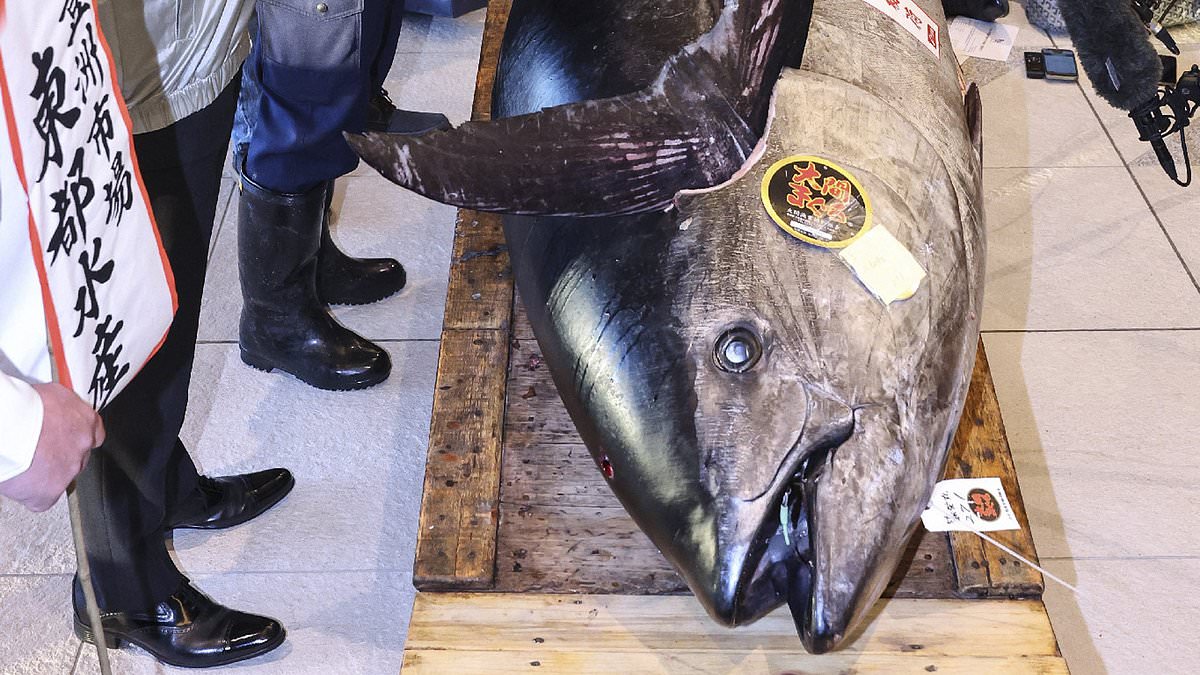A bluefin tuna has been sold for an eyewatering £1.05million in a Tokyo fishmarket.
The enormous 608lb fish, which was caught off the coast of Oma in northeast Japan, was caught by a 73-year-old fisherman called Masahiro Takeuchi on Saturday morning.
Takeuchi told reporters at the Toyosu market in central Tokyo: ‘It was as fat as a cow. It’s like a dream. I’m always worried about how many more years I can do this job, but I’m incredibly happy.’
The giant tuna was jointly bought by a wholesaler and a company that operates a popular chain of sushi restaurants.
‘The year’s first tuna brings good luck. We want to make people smile with food,’ said Shinji Nagao, the president of the sushi restaurant operator.
This year’s catch, however, is overshadowed by the 2019 sale of a bluefin tune for 333.6million yen (£2.5million that year).
The Self-styled ‘Tuna King’ Kiyoshi Kimura bought the 278kg (612lbs) bluefin tuna.
‘I bought a good tuna. The price was higher than originally thought, but I hope our customers will eat this excellent tuna’, Mr Kimura said after the 2019 auction.
This year’s massive sale sparked hopes that Japan’s economy would soon be on the mend, after a disastrous year for the yen.
The yen has been steadily decreasing in value since 2019. One key factor is this steady slide that has turned into a self-fulfilling loop that sees investors selling more and more of their reserves as they see more bad news about the yen.
As a result of the falling value of the currency, exporters are less likely to convert foreign currency into yen which further decreases demand and drives down the price.
This has led to a major increase in tourists to the Japan, who see the country’s weak currency as a chance to cash in on bigger purchases.
It has become such a problem that earlier this week, Japan pleaded with n visitors not to flood its main tourist areas and to explore the country beyond ‘what is trending on social media’.
The country is proving to be a magnet for Aussie adventurers as the n dollar surges against the yen.
A record 637,000 Aussies visited the country between January and September last year – a 42 per cent annual increase according to the Japan National Tourism Organisation.
This has prompted JNTO’s n office’s executive director Naoki Kitazawa to steer visitors away from the overwhelmed tourist hotspots.
‘Tokyo, Kyoto, and the Golden Route offer incredible experiences, but there’s so much more to discover beyond the obvious and what’s trending on social media,’ he said.
‘We strongly encourage ns to consider lesser-known destinations, as well as look at shoulder travel seasons, such as autumn, as well as Japan’s summer – known locally as the ‘green season’ where the country’s rural and regional areas really come into their own.
‘Don’t just stick to the postcard sights – venture out and uncover the stories that aren’t always on the tourist trail.’
